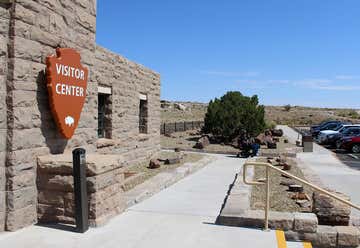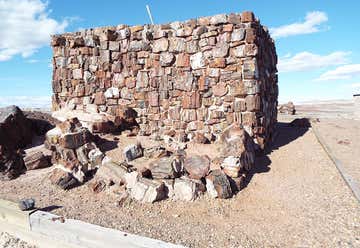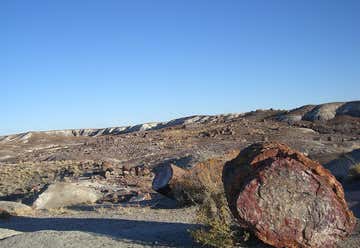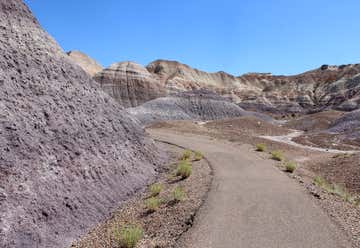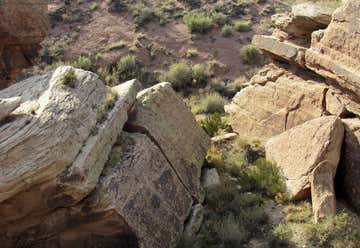Petrified Forest National Park is located in the greater Painted Desert in northeastern Arizona. The park is named for its large amount of petrified wood, fossils of fallen trees that lived 225 million years ago when the climate was humid and sub-tropical. Petrified wood retains the shape and texture of the original wood, but polishes to a shine like any other crystal.
Taking petrified wood from the park—even a small chip—is against federal law, but there are plenty of places nearby to buy rough or polished specimens in all shapes and sizes. There are two large shops conveniently located right outside of the park, with restrooms, snacks, and more than a few concrete dinosaurs.
Some tips for visiting Petrified Forest National Park:
A forest in the middle of Arizona’s grassland may sound odd, but Petrified Forest National Park is unlike any other forest in the country. The park is packed with gems—quite literally, since the ancient wood has been turned into sparkly stone—that anyone, from the outdoor enthusiast to the science geek, can enjoy.
The park’s location right off the highway means that many people at least drive through it (though it closes as early as 5 p.m., so plan accordingly). A portion of old Route 66 is located within the park. It's the only portion of the classic road to still be preserved within a national park (the asphalt is gone so it’s not drivable, but look for the old telephone poles marking the route). Wilderness camping is available within the park, and there are plans for a campground in 2021. Homolovi State Park, about an hour away, also offers camping options. Nearby Holbrook offers additional accommodation and camping options, including a KOA.
Don't let the glittering logs temp you into snagging a souvenir—removing any petrified wood from the park is illegal. You can purchase a box of petrified wood from a gift store (sourced from private lands), but don’t open it until you’ve left the park premises.
Summers in the park can get hot, with little to offer in the way of shade, and winters are often cold and snowy. Wildflowers pop up throughout the desert between March and October, especially in May, July, and August, so if you're looking for an extra colorful landscape, this is a good time to visit.
The Painted Desert Visitor Center is a good first stop on your tour of the park. It has an educational film, a gift shop, and plenty of petrified wood for sale.
The national park is home to the famous Painted Desert Inn, and even though you can't spend the night here anymore, you should definitely stop in to check out the exhibits (the inn was originally constructed of petrified wood, until a makeover in the 1930s). Don’t miss the displays of artwork from the park's resident artist program.
For the best views—and to see how the Painted Desert got its name—head to Kachina Point. Bands of different colored sediment in the rolling hills make for a perfect photo op.
There's more to Petrified Forest than its eponymous sparkly logs—it's also an important archaeological and anthropological site. Visitors can still check out the sandstone ruins of Puerco Pueblo, a once-bustling community that dates back to the 1200s.
Near Puerco Pueblo you’ll find a spiral petroglyph on a boulder that aligns perfectly with a beam of sunlight for about two weeks near the solstice. The shaft of sunlight travels down the side of the spiral and touches the center as the sun rises, peaking at 9 a.m. If you happen to be visiting outside of the two-week window, you can still see the boulder and read the informative sign nearby.
When you’re ready for a bite to eat, head to Aliberto's, a local chain that serves up authentic Mexican cuisine. If you only order one dish while in Holbrook, make it the green chile plate from Aliberto's—green chile is a local specialty, and after eating here you'll understand why it’s so popular.
Drive through the Painted Desert and Petrified Forest National Park in the late afternoon and then stop at Wigwam Village Motel #6 for the night. The rooms of this charming historic motel—located inside individual concrete and steel teepees—are pure roadside kitsch. There are only three remaining Wigwam Motels, and the vintage cars parked outside of each room make this the best one for photos.
The Turquoise Room is a hidden gem located inside La Posada Hotel. It's a refreshingly different experience from the many diners and fast food joints that line the highway. Here, you can sit down and enjoy a nice meal that feels like something you might find in a big city, with an Arizona twist.
During Winslow’s heyday as a stop for steam locomotives, Fred Harvey wanted to build a landmark hotel in Winslow. With a price tag that would equal nearly $40 million today, La Posada Hotel was completed just after the stock market crash. It would only be open for 27 years, eventually having most of its fine furnishings sold at auction, but efforts to save the Winslow icon were eventually successful.
Facing the threat of demolition for several decades, the La Posada Foundation and the new owners of the property finally restored La Posada Hotel to its former glory as the Jewel of the West. The foundation changed its name to the Standin’ on the Corner Foundation and took on its next project, helping to make the now-famous Standin' on the Corner Park a reality.
Inside the national park, the Rainbow Forest Museum featured hands-on exhibits and displays. Behind the museum is one of Petrified Forest's best hikes, the Giant Logs Trail. If you're limited on time and looking to get as much out of the park as possible, this is a great place to start.
Watching educational videos and looking at displays is a good way to get background on the petrified wood, but nothing beats seeing the actual thing up close. It’s a surprising experience to see so many sparkly, colorful logs in one place, and it’s hard to believe that these trees are 220 million years old.
The eight-room Agate House was likely built between the years 1050 and 1300, and was reconstructed in the 1930s. It was built using petrified wood and is still in remarkably good condition. See it for yourself by hiking the 2-mile round trip trail from the Rainbow Forest visitor center.
The Crystal Forest is an easy hike along a paved walkway. The loop, named for the quartz crystals sometimes found in the wood, takes you past piles of petrified wood. It's only three-quarters of a mile, but take your time and enjoy the views.
The 1-mile Blue Mesa trail takes you further into the Painted Desert, where the hills take on hues of gray, purple, and blue. It's definitely not a typical desert landscape—seriously, it looks like you're on a different planet—which makes it well worth a visit.
More than 600 archaeological sites have been found within Petrified Forest's boundaries—impressive for a park that's less than 150 square miles in size. The cryptic petroglyphs on Newspaper Rock were carved between 650 and 2,000 years ago. Visit and try to decipher their meaning yourself.









